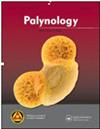晚寒武世Acritarch Goniomorpha Yin 1986的小碳质化石的孢粉恢复表明这是一种Priapulid蠕虫的牙齿
IF 1.3
4区 地球科学
Q3 PALEONTOLOGY
引用次数: 2
摘要
摘要中国东北吉林省小杨桥剖面被选为奥陶纪基底的辅助边界地层剖面和点(ASSP),该剖面的新的孢粉学研究证实了1986年在晚寒武纪(芙蓉阶)到早奥陶世(Tremadocian)的间隔中存在Goniomorpha Yin,并使我们能够阐明其形态和亲缘关系。尽管最初被比作具有由一极产生的突起的囊泡微体化石,但Goniomorpha缺乏封闭的空腔,因此不能严格意义上归类为肢端。相反,我们发现,最初被描述为Goniomorpha的标本实际上是更广泛形态的一部分,这些形态可被识别为普里普利德虫的咽齿。保存最完好的标本将“过程”分解为角质垫边缘的足弓产生的小齿,有时具有延伸的刺和多边形微观结构。据报道,寒武纪小型碳质化石(SCFs)组合和普里apulid Ottoia的Burgess页岩标本的原位形态非常相似。小杨桥剖面的发现将寒武系SCFs的埋藏范围扩展到了奥陶纪,为我国北方奥陶纪的原始盖层提供了第一个证据。更普遍地说,我们的结果证明了从孢粉学和SCF类型处理中识别有问题的微体化石的相互见解。本文章由计算机程序翻译,如有差异,请以英文原文为准。
Palynological Recovery of Small Carbonaceous Fossils (SCFs) Indicates That the Late Cambrian Acritarch Goniomorpha Yin 1986 Represents the Teeth of a Priapulid Worm
ABSTRACT New palynological studies from the Xiaoyangqiao section (Jilin Province, north-east China), which has been selected as an Auxiliary Boundary Stratigraphic Section and Point (ASSP) for the base of the Ordovician, confirms the presence of Goniomorpha Yin 1986 in intervals ranging from the late Cambrian (Furongian) to the Early Ordovician (Tremadocian), and allow us to clarify its morphology and affinities. Despite being compared originally to vesicular microfossils with processes arising from one pole, Goniomorpha lacks an enclosed cavity, so it cannot be classified as an acritarch in the strict sense. Instead, we find that the specimens originally described as Goniomorpha are actually part of a wider spectrum of morphologies that are identifiable as the pharyngeal teeth of priapulid worms. The best-preserved specimens resolve the ‘processes’ as denticles arising from an arch on the margins of a cuticular pad, sometimes with an extending spur and polygonal microstructure. Closely equivalent forms have been reported from Cambrian assemblages of small carbonaceous fossils (SCFs) and in situ on Burgess Shale specimens of the priapulid Ottoia. The findings from the Xiaoyangqiao section extend the taphonomic range of Cambrian-type SCFs into the Ordovician, and provide the first evidence for priapulids from the Ordovician of northern China. More generally, our results demonstrate the reciprocal insights from palynological and SCF-type processing for identifying problematic microfossils.
求助全文
通过发布文献求助,成功后即可免费获取论文全文。
去求助
来源期刊

Palynology
地学-古生物学
CiteScore
3.40
自引率
26.70%
发文量
48
审稿时长
>12 weeks
期刊介绍:
Palynology is an international journal, and covers all aspects of the science. We accept papers on both pre-Quaternary and Quaternary palynology and palaeobotany. Contributions on novel uses of palynology, review articles, book reviews, taxonomic studies and papers on methodology are all actively encouraged.
 求助内容:
求助内容: 应助结果提醒方式:
应助结果提醒方式:


